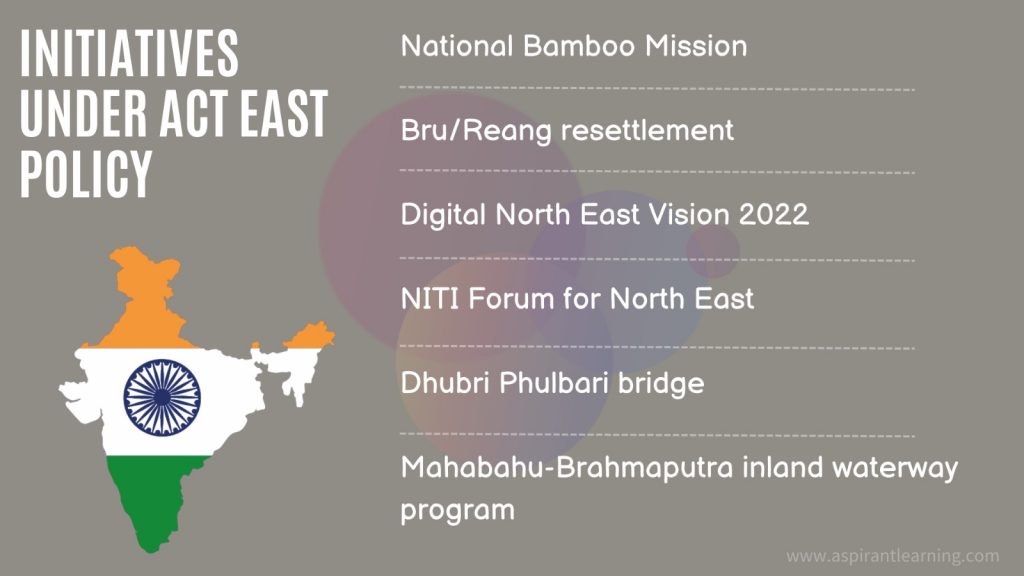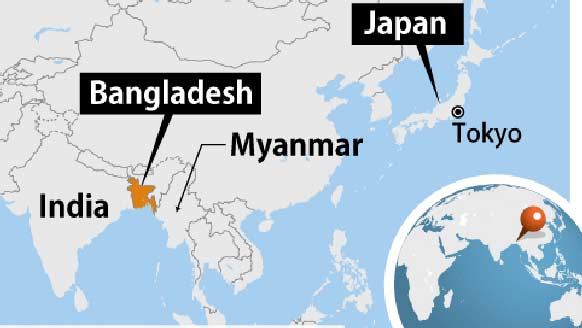News Highlight
The trio of Bangladesh, India, and Japan can influence the objective of connecting a significant section of South Asia with Southeast Asia by using the northeast as a focal point.
Key Takeaway
- The northeastern area of India (Arunachal Pradesh, Assam, Manipur, Meghalaya, Mizoram, Nagaland, Tripura, and Sikkim) is changing dramatically.
- It has solved several security issues and is now focusing on economic development.
- Political shifts have been beneficial.
- The vast web of ties with bordering Bangladesh is as well.
- Furthermore, Japan has emerged as a key development partner for India and Bangladesh.
- The third India-Japan Intellectual Dialogue (April 11-12, 2023), organised by the Asian Confluence (ASCON) in Agartala, Tripura, was an excellent opportunity to review experts’ and policymakers’ shifting views.
- It demonstrated that the present decade might bring about game-changing shifts in the northeast, bringing the troika of Bangladesh, India, and Japan closer together.
India, Bangladesh, and Japan to hold connectivity meet in Tripura
- Vision and opportunities
- One of the most significant projects is the development of the Matarbari Deep Sea Port (DSP) on Bangladesh’s southeastern coast.
- It is being built with Japanese aid and is slated to open in 2027.
- Recent ASCON research shows this port will be a “game changer.”
- To be economically successful, the port must serve the demands of Bangladesh and India’s northeast.
- The long-term goal is for Bangladesh and the northeast to become a regional hub and vital industrial corridor, serving a population of 220 million people.
- Japan’s Ambassador to India stated at the meeting underlined that increased road and rail connectivity is necessary.
- It is insufficient without the development of regional industrial value chains.
- As a result, fast industrialisation in industries where the northeast has a competitive edge becomes essential.
- This strategy is sound since it ensures the new connectivity links are exploited and productive.
- Job opportunities must accompany roads and ports.
- New industrial businesses established with domestic and foreign investment can only provide it.
- A shared focus on extensive connectivity and boosting industrialisation in Bangladesh and the northeast is anticipated.
- The northeast is rich in natural resources.
- Its strategic location, bordering Nepal, Bhutan, China, Bangladesh, and Myanmar, is advantageous.
- Creating value chains and producing products should include a variety of industries, such as;
- Agro-processing, man-made fibres, handicrafts, two-wheeler and maybe mobile phone assembly, and pharmaceuticals.
- With its high level of education, the populace already excels in the service sector, attracting the interest of potential investors.
Challenges
- Japan’s role as a sole investor in the northeast is untenable.
- Indian firms must also invest.
- India must relax limitations on investment from Bangladesh.
- The three governments should also strengthen economic cooperation ties.
- India can help Bangladesh become a key component of the Act East Policy.
- Two more points need to be addressed.
- First, while discussing regional cooperation and integration, it appears that little attention is paid to the self-defeating BIMSTEC.
- This must alter if the grouping is to achieve its goal of forming the Bay of Bengal Community (BOBC).
- Second, connecting a significant portion of South Asia with Southeast Asia necessitates an astute pilot.
- Bangladesh, India, and Japan (BIJ) might provide this leadership.
- A BIJ Forum should initially be established at the Foreign Ministers’ level, which will be welcomed in the northeast.
Act East Policy
- About
- The ‘Act East Policy’ was launched at the 12th ASEAN-India Summit in Myanmar in November 2014.
- The Act East Policy replaces the Look East Policy established in 1992.
- Unlike Look East, which focuses on economic cooperation with ASEAN states, Act East focuses on the Asia-Pacific region’s broader neighbours and includes security cooperation.
- It seeks to promote economic cooperation, connectivity and trade cultural ties.
- As well as promotes the development of a strategic relationship with countries in the Indo-Pacific region through a proactive and pragmatic approach.
- Hence improving the economic development of the North Eastern Region (NER).
- It serves as a gateway to the South-East Asia Region.
- AEP connects North East India, particularly the state of Arunachal Pradesh, to the ASEAN area.
Initiatives under Act East Policy
- Agartala-Akhaura Rail Link between India and Bangladesh.
- Intermodal transport links and inland waterways via Bangladesh.
- Kaladan Multimodal Transit Transport Project – The Kaladan transport project in Myanmar’s Rakhine state is critical in strengthening connectivity with the country’s landlocked northeastern areas.
- Trilateral Highway Project – This connects the North East with Myanmar and Thailand.
- Road and bridge projects and hydroelectric power plant upgrades have been done under the India-Japan Act East Forum.
- The Mahabahu-Brahmaputra inland waterway program-The launch of this waterway will be marked by the opening of the three Ro-pax vessels.
- It functions between Neamati-Majuli island, North Guwahati-South Guwahati, and Dhubri-Hatsingimari.
- Dhubri Phulbari bridge – The foundation stone for a 19-km-long four-lane Dhubri Phulbari bridge over the Brahmaputra river.
- It would be India’s longest river bridge, connecting Dhubri in Assam and Phulbari in Meghalaya, and will cost Rs 5,000 crores to build.
Significance of North East
- Northeast states is increasingly gaining strategic importance.
- With ASEAN involvement being a key pillar of India’s foreign policy strategy.
- These states play a crucial role as the physical link between India and Southeast Asia.
- The NER also provides enormous prospects for the business tourism market, given the appealing natural environment and expanding trends of outbound business meetings.
- With a participatory approach, heritage tourism has grown significantly in the Region.

Pic Courtesy: Nagaland Post
Content Source: The Hindu



